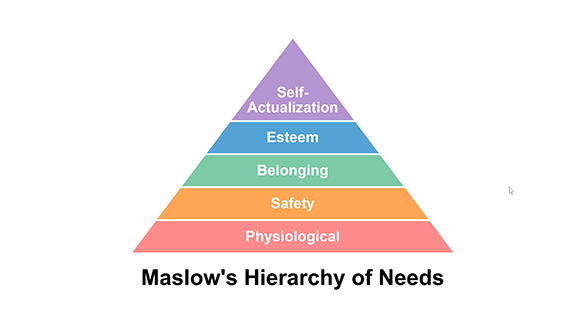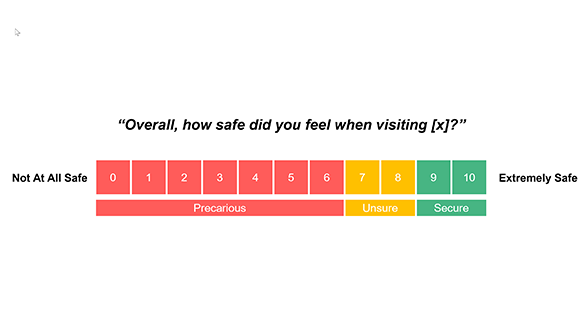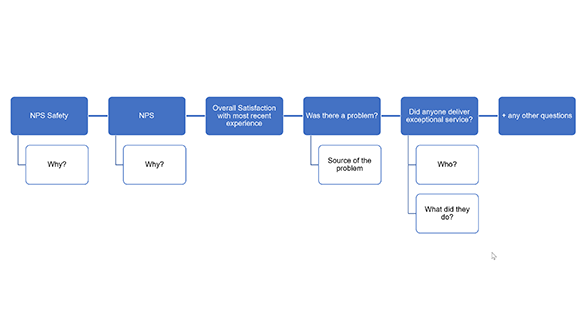(Yes and no)
(Yes!)
To do that, let’s start by understanding what motivates humans and how that impacts your VoC reopening:
Maslow's Hierachy of Needs and VoC
 Maslow's Hierarchy of Needs is a five-tier model of human needs, depicted above as hierarchical levels within a pyramid. The theory is that humans have basic needs that must be satisfied first (such as food, security, and safety) before higher order needs are considered or relevant (such as happiness, interpersonal connections, and accomplishment).
Maslow's Hierarchy of Needs is a five-tier model of human needs, depicted above as hierarchical levels within a pyramid. The theory is that humans have basic needs that must be satisfied first (such as food, security, and safety) before higher order needs are considered or relevant (such as happiness, interpersonal connections, and accomplishment).
The idea is humans need to know that they have food on the table, a bed to sleep in and a feeling of safety before they can focus on fulfilling their life’s purpose.
Maslow’s theory is a useful framework to consider when "reopening" your VoC program.
Pre-COVID-19, many VoC programs were mature and focused on higher order needs, such as how to measure emotional connections with customers, exceed service expectations, etc.
Now, your customers need to feel safe. Period. Full stop.
Nothing else will matter to your customers if their basic need to feel safe is not fulfilled by the experience you are delivering.
No matter how mature your VoC program is, a COVID-19 world calls for a serious safety reboot.
5 Recommendations for Reopening your VoC Program
Keeping Maslow’s Hierarchy in mind, here are five recommendations to reopen your VoC program.
These recommendations are assuming a post-transactional survey with people-based touchpoints (e.g., visit to retail store, hotel, customer home, etc.)
- Add an “NPS Safety” question in the very beginning of the survey. Safety is everything these days, so get to it right away in your survey. Yes, before NPS. Yes, before overall satisfaction.
Your FIRST survey question should be:
“Overall, how safe did you feel when visiting [x]?”
Make it an 11-point scale, just like NPS, anchored by “Extremely Safe” and “Not At All Safe.” You can then segment your customers into safety groups like you do with NPS – 9/10s are “Secure,” 7/8s are “Unsure” and 0-6s are “Precarious.”
- After the NPS Safety question, add an open-end to learn more. Immediately after your NPS Safety question, ask the following question: “Please tell us why.” These open-ends are gold.
You should have your VoC partner and/or your analyst reviewing these daily as customers return. These open-ends are critical to recommendation #5 below. - Set a Real-time Alert for any customer in the “Precarious” segment of NPS Safety. Any customer who does not feel safe based on their answers to “NPS Safety” should trigger an alert that should be worked just like any other alert pre-COVID-19.
This means assigning a person to find out why the customer felt unsafe, identifying the root cause of this feeling, providing detail on the root cause and identifying the operational change that must occur to prevent other customers from feeling this way in the future.
Operational changes can range from employee training, to store layout to customer flow within the store. - Keep your core transactional VoC questions. PeopleMetrics recommends the following flow to post-transactional VoC surveys:
- NPS Safety
- Why? (follow up open-end)
- NPS
- Why? (follow-up open-end)
- Overall satisfaction with most recent experience
- Was there a problem?
- Source of the problem
- Did anyone deliver exceptional service?
- Who?
- What did they do?
- PLUS, keep any questions you used pre-COVID-19. It’s important that customers feel like they can provide feedback on their overall experience, even during these times.

- NPS Safety
- Use the open-ended feedback from your NPS Safety question to eventually add other questions about safety to your survey. After you get between 500-1000 open-ended comments from your NPS Safety open-ended question, you should see some common themes emerge about safety that you will want to ask every customer.
Questions around employees using PPE, other customers respecting social distancing, and there being clear instructions on how to proceed through the experience are examples of what some of these safety themes could be.
Take 3-5 safety questions and add them as a section to your survey. This will allow you to monitor the overall feeling of safety along with the drivers of safety in real-time.
I hope these recommendations will help you navigate the customer experience during these uncertain times.
In the end, getting and acting on feedback from customers on how they feel about their safety is the most important priority of any CX or VoC professional (or any business for that matter) for the foreseeable future.
○ ○ ○
About the Author
Sean McDade, PhD is the author of Listen or Die: 40 Lessons That Turn Customer Feedback Into Gold. He founded PeopleMetrics in 2001 and is the architect of the company’s customer experience management (CEM) software platform. As CEO, he guides the company’s vision and strategy. Sean has over 20 years of experience helping companies measure and improve the customer experience. Earlier in his career, he spent five years at the Gallup Organization, where he was the practice leader of their consulting division. His company offers CEM software with advanced machine learning solutions and hands-on analytical support to help companies make sense of their CX data. Sean holds a Ph.D. in Business Administration with a specialization in marketing science from Temple University in Philadelphia. He has published eight articles in peer-reviewed scholarly journals and has taught over 25 marketing classes. Sean was named a 40 under 40 award recipient of the Philadelphia region. He is an active Angel Investor, including investments in Tender Greens, CloudMine and Sidecar.
Topic: Customer Experience





%20(1).png)